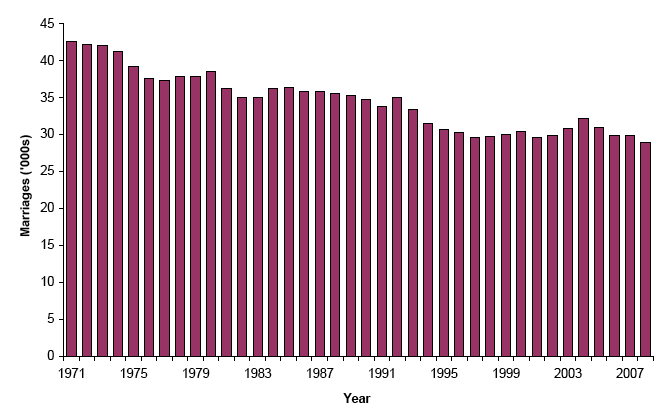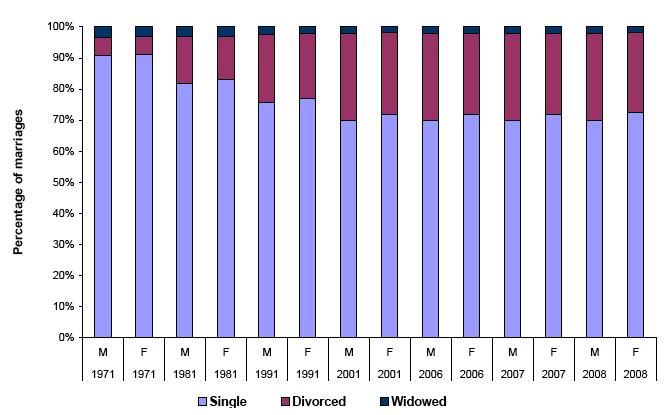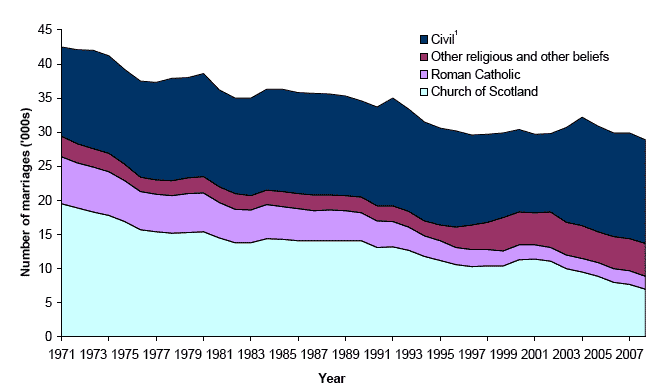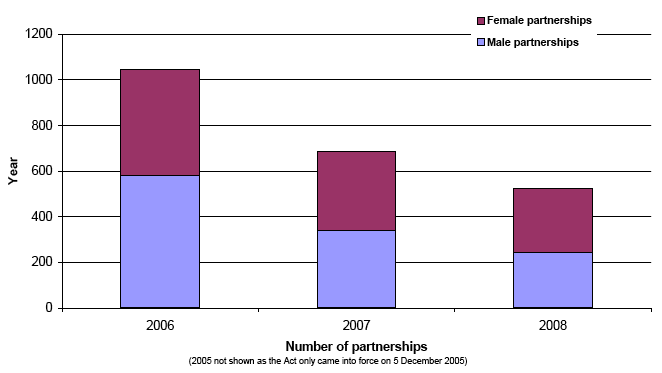
Marriages
There were 28,903 marriages in Scotland in 2008, 963 (3.2 per cent) fewer than in 2007. Figure 5.1 shows that, following a decline from over 40,000 marriages a year in the early 1970s, the annual total has levelled out at around 30,000. The highest total recorded in recent years was 32,154 in 2004 whilst the 2008 total is the lowest since Victorian times.
The information in this section covers all marriages registered in Scotland, regardless of where the bride and groom lived. In 2008, there were 7,354 marriages (25 per cent) where neither the bride nor groom was resident in Scotland. This represents a slight fall from 7,959 (27 per cent) in 2007. Gretna continues to be a popular venue for marriages, though the 4,157 registered in 2008 was a quarter down on the record total of 5,555 in 2004. In 2008, 85 per cent (3,536) of the marriages at Gretna did not involve a Scots resident.
Of course, many couples who live in Scotland go abroad to be married. These marriages are not included, and only some come to the attention of the Registrar General through notification to British consular authorities.
Figure 5.1 Marriages, Scotland, 1971-2008

Marital status at marriage
Figure 5.2 shows the percentage of marriages by marital status at the time of marriage between 1971 and 2008. The percentage of people marrying who had been divorced rose from just under 6 per cent in 1971, to over a quarter in 2008 (28 per cent for grooms and 26 per cent for brides). The majority of this shift reflects a reduction in the proportion of marriages where one of the partners had never been married. However, the proportion of those marrying who were widowed has also declined slightly in 2008, the proportion was just over 2 per cent whereas it was just over 3 per cent in 1971.
Figure 5.2 Marriages, by marital status and sex of persons marrying, 1971-2008

Age at marriage
The average age at marriage continues to rise for both males and females. For first marriages, the average age of grooms who were bachelors has risen from 29.8 in 1998 to 32.5 in 2008; the comparable figures for brides who were spinsters are 27.9 in 1998 and 30.6 in 2008.
Marriages by type of ceremony
All civil marriages are conducted by registrars, and they have wide discretion over the form of the ceremony, to meet couples' wishes, as long as there are no religious references. There were 15,201 civil marriages in 2008, when they accounted for just over half (53 per cent) of all marriages compared to just under one-third (31 per cent) in 1971 (Figure 5.3). The trend mainly reflects a decline in the number of religious ceremonies during the past thirty to forty years. The small increase in religious marriages observed during the period 1997-2002 was largely associated with the increase of ‘tourism’ marriages, of which a significant proportion were carried out at Gretna.
Religious and other belief system marriages are conducted by a wide range of celebrants. The largest number of religious marriages were carried out by ministers of the Church of Scotland, who conducted 7,007 marriages in 2008. The other celebrants conducting at least 500 marriages in 2008 were the Roman Catholic Church 1,873, Humanist Society of Scotland 1,026, Scottish Episcopal Church and other churches of the Anglican Communion 727, Assemblies of God 671 and the Methodist Church in Scotland 525.
Humanist celebrants have been authorised to conduct marriages in Scotland since 2005 and, in 2008, they officiated at 1,026 marriages, compared with 710 in 2007 and 434 in 2006.
Figure 5.3 Marriages, by type of ceremony, 1971-2008

1 Civil marriages includes very small numbers of "irregular" marriages established by Decree of Declaration of the Court of Session.
Until 2002, civil marriages could only be held in registration offices. The Marriage (Scotland) Act 2002 allowed registrars to conduct ceremonies in other approved places, from June 2002. In June 2009, there were more than 700 approved venues in Scotland, including castles, hotels, clubs and a small number of outdoor venues in gardens or the countryside.
During 2008, 8,003 civil ceremonies (28 per cent of all marriages and 53 per cent of civil marriages) were conducted at these ‘approved places’. Although showing very little change from the 7,987 ceremonies in 2007, this represented an increase of 131 per cent on 2003, the first full year of the new arrangements. There has been a corresponding decrease in the number of religious marriages, from 16,890 in 2003 to 13,702 in 2008.
In 2008, 61 per cent of the religious marriages were celebrated in places of worship while just under half (47 per cent) of civil marriages took place in registration offices. Hotels were the venue for about 1,900 religious and 3,300 civil ceremonies, while approximately 900 religious and 700 civil marriages took place in castles and other historic buildings. 64 religious and 103 civil marriages were held on ships and barges or close to water.
Civil Partnerships
The Civil Partnership Act 2004, which applies throughout the UK, came into force on 5 December 2005, allowing same-sex couples to register their partnership.
During 2006, the first full year of operation, 1,047 partnerships were registered in Scotland. In 2007, 688 partnerships were registered - this decrease was expected, because many long-standing relationships would have been registered as civil partnerships in the first full year of registration in 2006. In 2008 there was a further decrease to 525 registered civil partnerships – 245 male couples and 280 female couples (Figure 5.4).
Figure 5.4 Civil partnerships, 2006-2008
